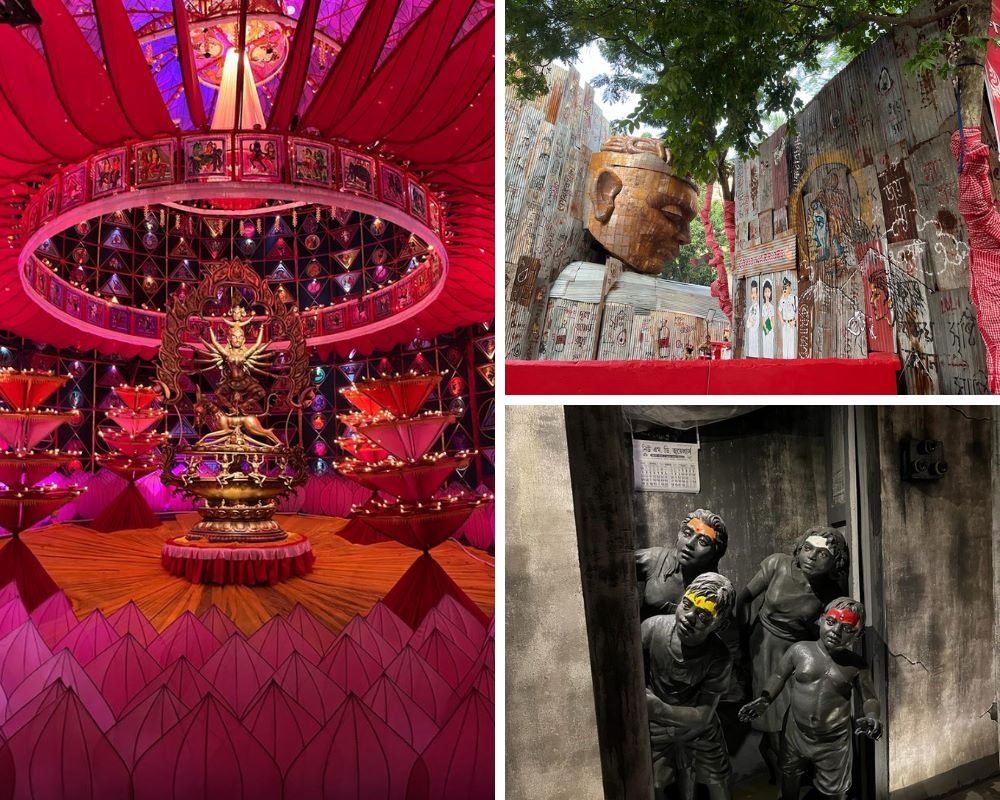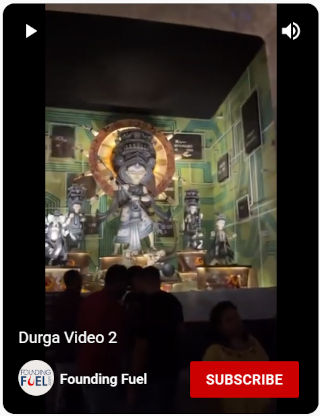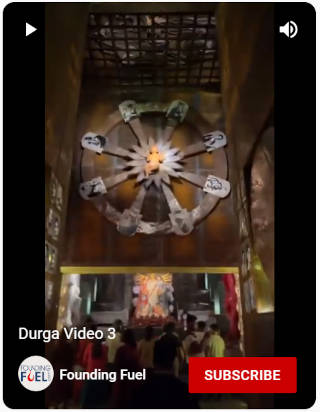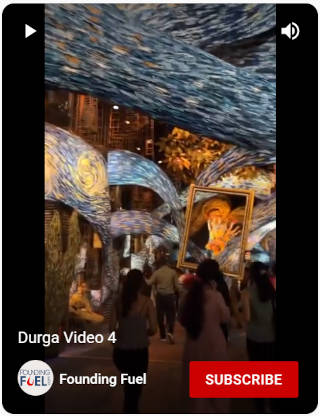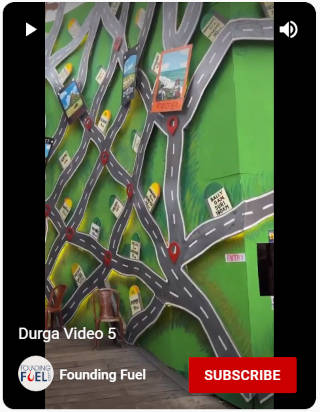When asked to write an article on Durga Puja, I felt particularly unqualified. When it comes to religion, I am zealously avoidant. If I have attended a ritual during Durga Puja it was entirely inadvertent. But there is one reason that makes me bizarre, and thus, bizarrely qualified. Every year, for the last 20 or so years, my family and I have assiduously visited between 150 and 200 pandals per year, in the ten-day festival. I must have seen close to 4,000 pandals (and that’s probably an underestimate). That's quite ridiculous. You’re probably wondering why. I’ll get to that.
I thought that a good reason to write this article was that Durga Puja was recently certified a UNESCO Intangible World Cultural Heritage List. I was heartened. I eagerly looked online to find out what other fabulous cultural events were thusly certified. I expected the Dia de Muertos in Mexico, the Carnival in Rio, maybe the Burning Man Festival in the US. I was crestfallen to see the list had such mundane activities on there like Lavash preparation in Armenia, avalanche prediction in Switzerland. I checked to see if India had any entries, and it did. Parsi New Year.
I have nothing against Lavash-eating Parsis who might be overrun by an unpredicted avalanche. But Durga Puja is larger than that. It is one of the, if not the largest, street art festival, on par with the greatest art out there. If someone asked me if I preferred going to the Tate Modern in England, versus any Durga Puja year in Kolkata, I would always pick Durga Puja.
I suppose you have an overwrought Bengali in your office who goes on and on about Durga Puja when the time comes. They describe in great detail how the city is overrun with pandals, bringing the people together with a level of invention surpassing every previous year. Then an innocent voice compares it to some other inane Indian festival. Sadly, one can’t berate someone else's culture (but why they were looking through a sieve, and why it is noteworthy will always be beyond me). I often watch as the deflated office Bengali looks mournfully on knowing they have convinced no-one of Durga Puja’s exceptionality. Dash and folly. I too had long long ago given up trying to convince people that Durga Puja was nonpareil (I had made a ppt once). But once a year, my Instagram sparks to life and catalogues the city’s art.
The legacy of my family and Durga Puja is a long one. Many decades ago, my father was in an advertising agency. He was part of a team briefed by Asian Paints to come up with a stratagem to get acceptance in the Calcutta market. (British Paints, now called Berger Paints had factories in West Bengal, and thus a pre-primered loyalty). The agency came up with a solution, awarding the most creative Durga Puja Pandal with an award. Those awards continue to this day, and have since sparked a revolution.
One has to also understand why Kolkata’s creative spark is so virulent. Remember that it's a city that once was magnificent. Pre-Partition, it was wealthy, one of the wealthiest cities, in one of the wealthiest states, and the centrepiece of British rule in India. A combination of the Partition, and many years of a government that de-prioritized urban development, led to a mass efflux of companies (you can now count the head-offices still based in Kolkata on one hand), and a mass diminution of the wealth. Kolkata is thus a city without the affluence of Mumbai or Delhi, but with the remnant of taste of the once-wealthy. While other cities peg their socio-economic status on the cars owned, or the newness of their watches, Kolkata pegs it on the number of books read, and the artistic merit of the pandal in their locality.
In the 1980s unique pandals were commemorated in black and white photos that sold for 25 paisa. Slowly but surely creativity crept from the pratima (idol) to the surrounding pandal. In the early 2000s, a pandal in Bose Pukur captured the imaginations of the Bengali zeitgeist by making the pandal structure entirely out of clay cups so typical of Kolkata tea stalls. This began a revolution of the material used being the draw. A few years later, I think it was Haridevpur that mastered the art of the theme. One particular pandal that stands out starkly in my memory is Durga representing the suppressed housewife, with the possessions around the household, from rolling pins to iron beds forming a cage around her. Themes had existed before, there have been stamp-themed pandals, and Lego-themed pandals, but this was the first time an emotion at the centre of the theme hit as hard.
Let me give you another example. It was the beginning of the pandemic. Naktala Udayan Sangha chose to theme its pandal around migration. The pandal was a train station, with road markers from Bangladesh to West Bengal. Instead of music, the speaker system announcements said things like “Please do not leave your children, they will not be taken care of”. It was mesmerizing, and melancholy. It was a tangential reference to the worker migration that had happened at the beginning of the pandemic, and it touched upon the generational trauma of the years before. This year the theme of the pandal was the unsung women and their stitching work. One of the larger embroideries was a map of an undivided Bengal. It was enough for this pandal to trigger a memory of a previous pandal in that area. Thus, pandals build upon their art from year to year. Each emotion stacking upon one another, that the observant repeat visitor might notice.
Themed pandals are now quite the norm. Renowned artists have taken it a step further. A couple of days ago, I was at breakfast with a few friends of my parents. One of them is an art collector, and the other two know art well. They were having a serious conversation about how a pandal artist, Sushanta Paul, was on par as an artist with Anish Kapoor. Each of his pandals are exquisitely constructed, each generating a sense of deific awe. He likes to play with scale and perspective. His ambition is quiet, but phenomenal. He uses an intelligent sonic landscape to heighten his art. He is as much a fine artist as the best names in the business.
I leave the rest of this article as more an image journal, with a few blurbs to guide you through it.
Let's delve into three works from Sushanta Paul this year. The first is Tala Prattoy.
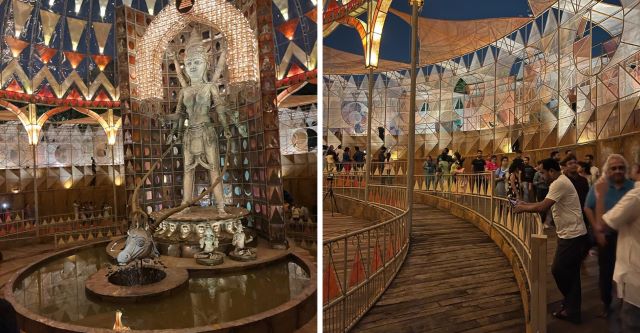
Apart from the obvious, a 30-foot-tall Durga in the centre (hardly the biggest), the pandal is surrounded by very soft curves in a metal structure. The theme behind the pandal is ritual. If you look closely in the second image you’ll see people, who are tasked with pushing the metal panels, and rotating it around the pratima inside. I’m not entirely confident that ritual isn't perhaps an excuse for not investing in motorised movement (something done with aplomb in previous years, we’ve even had cylinders on their side that rotated around the audience). Of course, no images will ever do justice to the actual experience, I’ve used a very high exposure to get some semblance of the colours, but the entire construction is darker, and consequently more mysterious than my pictures make it appear.
The second is from Vivekananda Athlethic Park in Haridevpur.
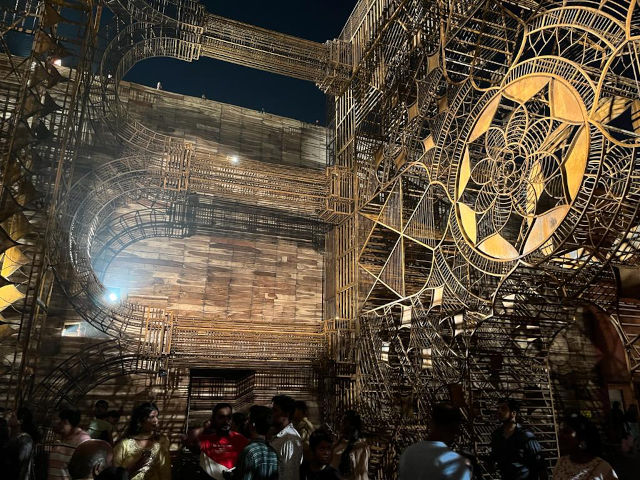
You enter cautiously through some slightly Islamic flower patterns. Its magnificence and calm is utterly disorienting, and it takes you a while to realise that the entire thing is the metal skeleton of a temple structure lying on its side. In the “ceiling” of the temple (i.e. the wall in front of us) is the pratima that looks like it’s made from beaten bronze (it’s actually clay).
I, unfortunately, don't have very good coverage of our next Sushanta Paul, which is in a place called 95 Pally.
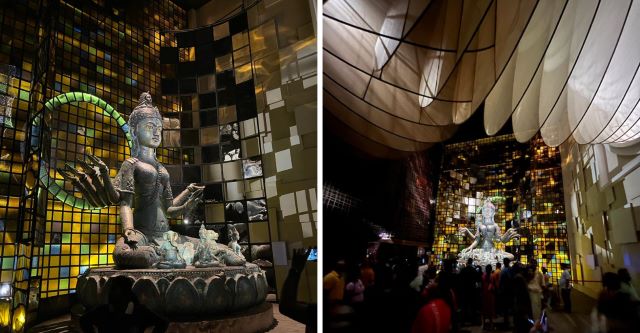
The majestic and Buddhism-inspired Durga idol holds no weaponry. Overhead is a massive aerial sculpture, that would look at home in an art gallery in Zurich. In the last picture you’ll notice that the left side is structurally incomplete, and the right is structurally futuristic in panelling. I’m not sure if that’s meant to signify a transition (the ethereal overhead sculpture transitioning from the traditional to the futuristic), or that the festival of Durga Puja is a Buddhist balancing act between the old and new.
Moving onto other artists, we have a video walkthrough of Naktala Udayan Sangha.
It starts with some museum-like reverence to everyday stitching objects. It moves on to celebrate the fingerprints of different artists before revealing Durga housed within a loom. Right at the end of the video you can see a large embroidery of undivided Bengal. The wall, whose image I’ve attached below, you’ll notice is plastered over sewing machines.
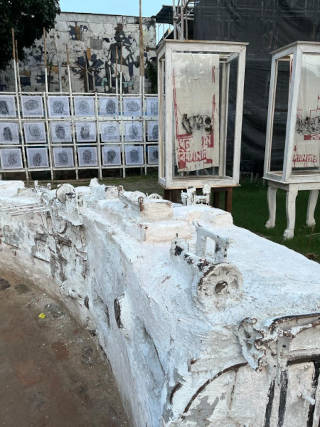
Next up we have Rajdanga Naba Uday Sangha.
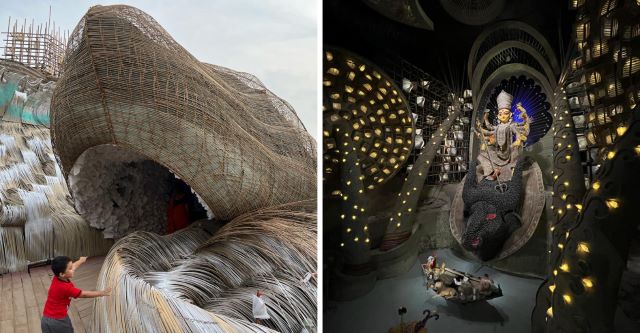
The theme is plastic in the oceans. You enter through the mouth of a whale. The boy is pointing excitedly, because he’s realised the inside of the whale, the baleen is made of white plastic bags. Through a contraption set up inside, the plastic bags inflate and deflate thus simulating the whale breathing in and out. Durga herself is surrounded by the leviathans of the ocean, with the bull’s head Asura covered with barnacles. I’ve taken an insert of the back wall at high exposure, to show that the impressive artwork is made up of nothing but cloth intelligently fashioned. But to the casual eye, it’s an underwater Gaudi.
The next is a Doordarshan-themed Durga Pandal. Notice the idols themselves are black and white, and behind them are the capacitors of an old cathode ray TV set. The soundtrack is several Doordarshan ads, and the iconic calling tune.
Second to last, we have a pandal themed on Acid Burns in Santoshpur Avenue South. Gut-wrenching and difficult art material, but an art festival should span the spectrum of emotion. It starts oddly with lipstick on primates (fashioned over the three wise monkeys), before moving to what we may consider conventionally beautiful women before showing us real life acid victims. The family of Durga stands in solidarity, with a sisterhood of women in the centre piece. Above them drips three Asuras from the head of what looks like an acid bottle.
Van Gogh is next at Bakul Bagan, and I must admit, I was sceptical when I heard about the idea, but it is well executed. We walk into a picture frame, and the thick strokes of Vincent’s oil brush is substituted with cloth and paper mache.
A pleasantly low-cost travel-themed puja at 21 Palli to end us off. The plane tickets have the names of the Durga family, flying in from various parts of India. Also a nice touch is each travel bag. For instance, the travel bag packed for the mountains has woolies and the picture of the destination on the lid. I include this, because even if it is lower on the scale of artistic merit, or budget, you’ll see that there’s creativity on nearly every street corner.
I’ll take your leave with a smattering of other images from across the several pandals we went to.
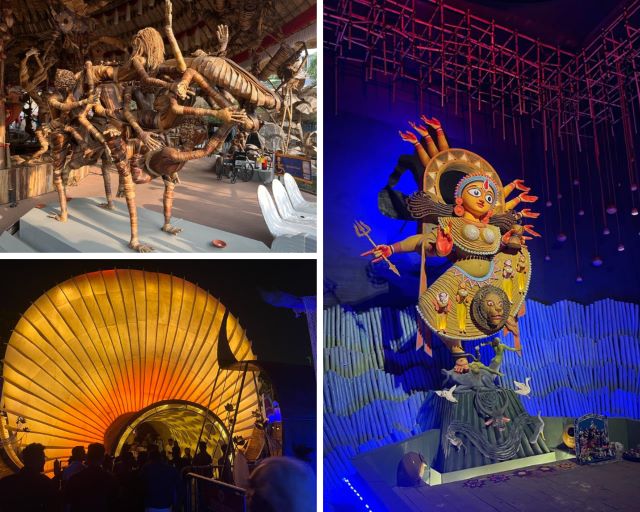
One day, an excited office Bengali will wax lyrical about Durga Puja. Turn to them, look them in the eye and tell them with conviction that it deserves to be treated better than Lavash.

